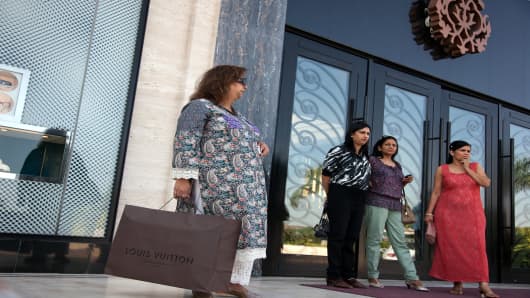For Gracie Salis, a 52-year-old Indian national living in the country's financial capital Mumbai, the surge in fresh food prices and higher transportation costs stemming from a rise in fuel costs, has forced her to scale back on discretionary purchases.
"My salary hasn't risen at the same level as the increase in prices. Vegetables like onions and potatoes have doubled from a year and a half ago; taxi and auto rickshaw fares have gone up. We cannot afford to live lavishly," Salis, a hair stylist who works at a five-star hotel in the city, told CNBC.
As a result, Salis has been cutting back on non-essential spending such as clothing, and opting to dine at home instead of eating out.
Salis is one of many consumers across Asia's third largest economy who are turning cautious on spending. The pullback in private consumption, the bedrock of India's economy that makes up around 60 percent of gross domestic product (GDP), is posing a threat to the country's fledgling recovery, said economists.
"Private consumption has been dropping at a fast pace over the last year. It's a major factor driving the slowdown. We aren't seeing signs of a turnaround," said Rahul Bajoria, economist at Barclays, adding that the bearishness is also being felt in the stock markets.
"Sentiment among consumers is quite negative. You can even see among retail investors in the stock market - they aren't allocating money to stocks," he added.
Private consumption grew 4.6 percent in the October to December months, a sharp slowdown from the 7-10 percent growth rates seen in the past decade. The weak consumer sentiment is showing up in various sectors of the economy, from air travel to the once thriving auto industry.
Domestic air travel fell 9 percent in February year on year, according to the International Air Transport Association, compared to an average rise of 3.9 percent globally. Car sales declined by around 7 percent in the year to March 2013, compared with the same period a year earlier, the first contraction in more than a decade.
Even consumer sectors that have traditionally seen double digit annual growth, such as apparel or fast moving consumer goods (FMCG), for example, are now seeing single digit growth, said Arvind Singhal, managing director of Technopak, a management consulting firm.
(Read More: India's Investment Malaise Thwarting Quick Economic)
The cutback in spending comes amid decelerating growth in the economy. India's economy grew at a decade-low pace of 5 percent in the fiscal year which ended March 2013.
"Uncertainty in terms of the economy and job security is holding consumers back from buying big ticket items like cars and real estate," said Dheeraj Sinha, chief strategy officer, South and Southeast Asia at global advertising and marketing agency Grey. "Also, middle class consumers are feeling the pinch of inflation," he added.
Easing Inflationary Pressures?
Still, Technopak's Singhal believes the slump in consumer sentiment has reached a bottom, pointing to positive expectations for the June-September monsoon season - which is constructive for consumption in rural areas - and signs of moderating inflation.
(Read More: Is India's Inflation Headache Finally Over?)
India's headline wholesale price index (WPI), which is closely watched by the country's central bank, eased to below 6 percent in March for the first time since 2009, a sign that the days of stubborn inflationary pressures may finally be behind the economy.
While logging double digit increases, consumer price inflation has also been easing. Consumer price inflation was 10.4 percent in March, significantly below February's 10.9 percent. It is expected to moderate to around 7 percent by March 2014, according to Morgan Stanley.
"With inflation under control, lending rates will come down, leaving companies with more capital to invest...investment leads to job creation," he said.
Leif Eskesen, chief economist, India and ASEAN at HSBC agreed, noting that he expects a pickup in consumption later in the fiscal year ending March 2014.
"We expect a slight uptick in consumption growth as consumers become more confident about the economy and employment prospects," he said.
Economists forecast a gradual recovery in India's economy of around 6 percent in the current fiscal year, as government spending and monetary easing help to spur domestic demand.
(Read More: India's Chidambaram Sees
8% Growth by 2015)



